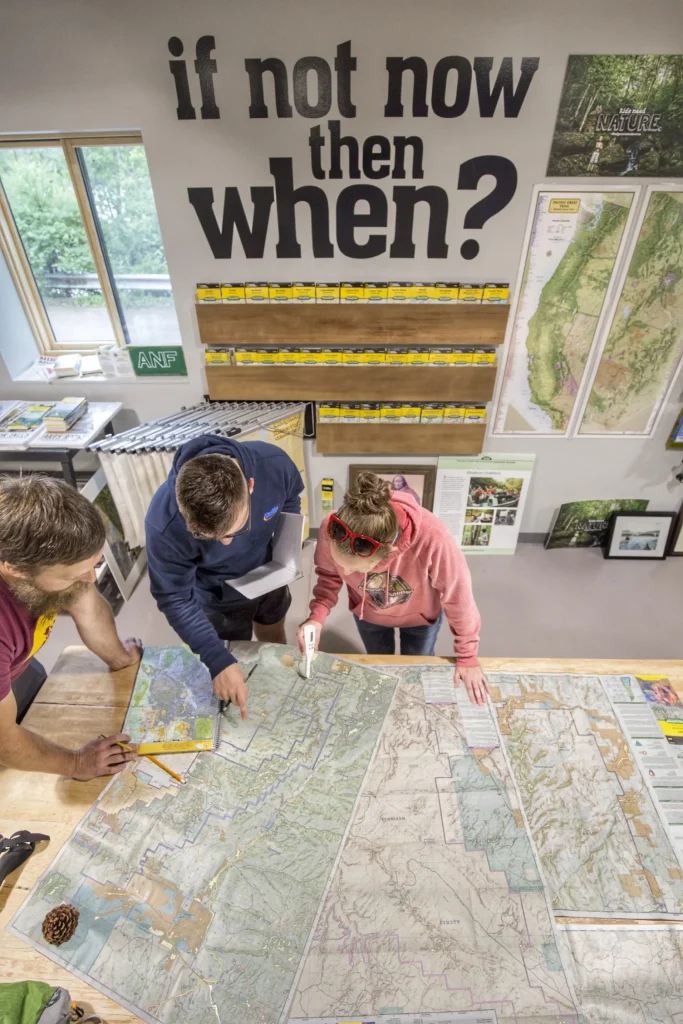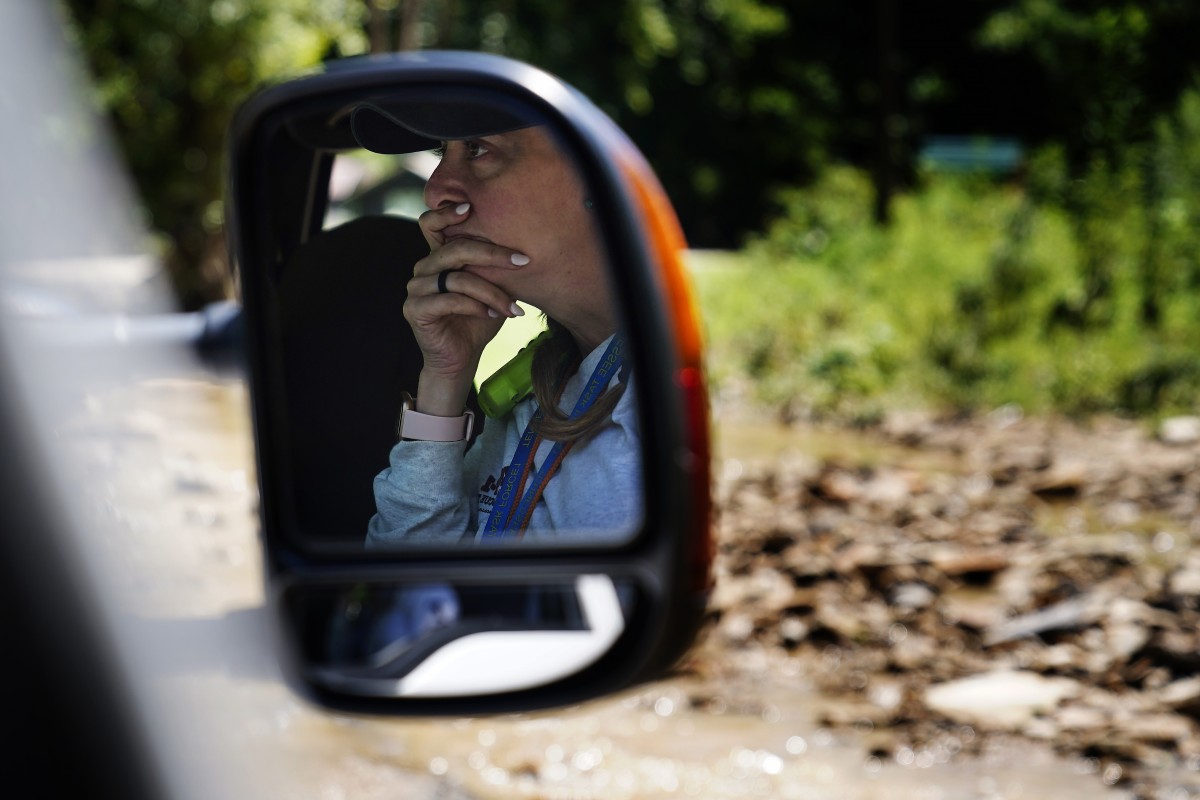All across Appalachia, there are examples of a growing outdoor economy.
Damascus, Virginia, hosts thousands of bicyclists a year who whiz downtown on the local rail trail, the Virginia Creeper. Colorful characters include a man who cycles with his pet macaw so he can feel the breeze through his feathers.
Darnell Farms in Bryson City, North Carolina, hosts a Strawberry Jam Festival every May. Guests pick their own berries, listen to live music, and watch the mule team farming demonstration.
In Phillipsburg, Pennsylvania, a global producer of rock-climbing gear, Organic Climbing, employs 31 people at its state-of-the-art solar-powered sewing factory, located on a reclaimed coal strip mine.
Travel is a $60 billion industry in the region, and at least two-thirds of visitors participate in some form of outdoor activity. However, the economic impacts are not evenly distributed, with half of the activity taking place in less than 10 percent of the region’s 420 counties. It is concentrated in urban areas and a small handful of popular small towns. A movement is underway to help rural towns and villages access the benefits as well.
Converging cultural factors are making this the moment to expand the outdoor economy in Appalachia. Travelers want authentic experiences of the outdoors and local foodways, and West Virginia has its first national park, New River Gorge. The pandemic has caused people to reevaluate their priorities and seek everyday quality of life. Many people are able to work remotely and live anywhere, and companies are looking to reshore their manufacturing. “We can’t move quick enough,” said West Virginia development professional Jina Belcher.
While previous Daily Yonder analysis has shown there can be downsides for recreation hot spots, those in the region who are successfully generating a more expansive outdoor economy have an intentional “a-rising-tide-lifts-all-boats” perspective. They have found that working across traditional lines, of both responsibility and geography, is a practical necessity.
Nonprofit leader Ta Enos of Pennsylvania sums it up: “The challenge for us in the beginning was can an underserved region that has been through a lot of hardship, left to fight over scraps, with a bit of a self-esteem problem, put our differences aside and come together in a real way to grow this new industry, for the good of all our communities?” The answer, as shown by the following stories of cooperation and collaboration, seems to be an unequivocal “yes!”
A Success Story
More than 30 years ago, two residents of southwest Virginia came back from vacation with a relatively new idea: to turn an old 34-mile railroad bed into a multipurpose trail. Thanks to their vision and commitment, the Virginia Creeper Trail opened in 1987.

The Creeper connects National Forest land and two communities, Damascus, population 700, and Abingdon, population 8,100. Usage of the trail has steadily grown and now it welcomes close to 250,000 visitors a year, including a record number through the pandemic. It has a significant impact on Washington County.
It is just one of the draws of Abingdon, which is the home of the popular Barter Theater, a 22-block historic district, and a competitive small-town food scene.
For Damascus, the Creeper solidified its status as Trail Town USA. In the 1930s, the Appalachian Trail was routed through its downtown, making it one of only three communities directly on the trail. The town hosts the Appalachian Trail Days Festival, an annual celebration and reunion with 20,000 people. This summer, the Damascus Trail Center will open in partnership with the Appalachian Trail Conservancy, one of three such centers on the 2,194-mile trail.
The TransAmerica Bicycle Route made its way through the community in the 1970s, bringing long-haul bikers crossing the country. Since, it has become the intersection for birding, heritage music, dirt bike, and mountain biking routes.
The popularity of all of these routes is on the rise; the Appalachian Trail has gone from fewer than 1,000 thru-hikers in the 1970s to more than 8,000 in the 2010s. But it is the Creeper that has economically transformed the town. According to a 2011 analysis by Virginia Tech, more than half of local businesses (including the seven bike outfitters) attribute more than 60 percent of their business to trail users.
The trail’s success is thanks to more than just these two communities. The Virginia Creeper Trail Advisory Board has representatives from co-owners Damascus, Abingdon, and the U.S. Forest Service, plus county officials and private landowners. Much of the work in entrepreneurial development takes place on a county level, with the annual Washington County Business Challenge awarding $32,000 to new and expanding businesses.

And the rail trail has spurred more outdoor economic development in the county. The Mendota Rail Trail is under development, and a rafting business is opening soon.
Building Rural Capacity
A catch phrase in community development is “building rural capacity.” Basically, it acknowledges that rural resources are stretched thin and communities need sustained assistance for new initiatives. With strategic help, local leaders can develop the skills, knowledge, and resources they need to adapt and thrive in a fast-changing world.
One organization in this work is the Conservation Fund, a national nonprofit that creates conservation solutions that make economic and environmental sense. Since 2007, it has spearheaded the Appalachian Gateways Community Initiative in partnership with Appalachian Regional Commission (ARC) and the National Endowment for the Arts.
The initiative has worked with leaders in more than 100 communities adjacent to public lands in the region. Each community team, comprised of four to seven people, includes at least one community leader, one public lands manager, and one arts representative. The training program (the next one begins this fall) combines webinars, a multi-day in-person workshop, and individual coaching over the course of several months.
Through the process, each team learns about the specific opportunities for sustainable economic development in gateway towns. They then develop a community action plan for a collaborative project to enhance infrastructure, amenities, services, programming, or marketing. “The coaches give communities a lift when needed,” said staff member Susan Elks.

They also help communities access funding. Participants are eligible for a grant opportunity, and the initiative staff share about opportunities like the U.S. Department of Agriculture (USDA) Rural Placemaking grant and a new program through the Economic Development Administration.
North Carolina is taking a statewide approach to building capacity. The state’s number one industry is agriculture and it’s a national leader in agritourism, which includes swanky outdoor weddings, rustic annual harvest picnics, U-pick berries, and farm stays.
“Agritourism fills in the seasonal income gaps and evens out revenue streams for producers,” said Annie Baggett, the state’s Department of Agriculture agritourism promoter. “It could be what keeps a farm or rural community going.”
Baggett knows well the balancing act many farmers perform. Through her work, she guides those who are launching agritourism components of their business. A cooperative extension curriculum helps them strategize and develop a business plan.
Baggett’s biggest role is marketing. In 2019, she helped launch a new mobile app, Visit NC Farms, to promote the hospitality of producers across the state. Representation on the app, which is available across popular app stores, is coordinated on a county level. Her outreach — mostly through the pandemic — increased the number of counties represented from twelve to 83. “Often in communities, we are the connectors between people in tourism, agriculture, and economic development,” she said.
The state increases rural capacity through their expertise and focus. For example, their marketing is tied to the Weather Channel; a sunny forecast generates ads for outdoor experiences, and rainy weather pushes indoor spaces like farmers markets.
Working Entrepreneurially
In 2004, the Pennsylvania Department of Conservation and Natural Resources (DCNR) decided to enact landscape-scale resource management. They divided the state up into regions and instigated locally-driven planning, natural resource conservation, and community renewal.
The Pennsylvania Wilds region is the most rural area of the state. Its 13 counties contain more public land than Yellowstone National Park, spanning 29 state parks, 8 state forests, 50 state game lands and Pennsylvania’s only national forest.
DCNR’s sustained commitment and strategic investment in visitor experiences provided a crucial foundation. The regional industry cluster now has 400 business and organizational members, each of them doing what they do best in an effort to align, not duplicate. Their collective work led to a 46 percent increase in tourism industry spending between 2009 and 2019.
“It’s rural entrepreneurs, public land managers, tourism and heritage professionals, game and fish commissions, county planners and elected officials, business service providers, conservation organizations, and economic developers,” said Ta Enos, founder and CEO of the nonprofit PA Wilds Center for Entrepreneurship.
Beyond strategies to make the PA Wilds a destination, the center is innovating ways to integrate local entrepreneurs — artisans, manufacturers, brewers, graphic designers, and photographers — into their work. Shops at busy state parks in the region are operated by the center. A full 90 percent of the products are sourced regionally. Small producers are able to tap into the trademarked PA Wilds brand and cooperative marketing efforts with the goal of growing rooted wealth through local entrepreneurship.

“Market-based approaches like this that systematically drive visitor dollars and other investment towards hyper-local businesses and organizations are needed to counter the macro forces we’ve seen gut rural communities across Appalachia and America and are critical to helping rural landscapes leverage their outdoor economies,” said Enos.
The PA Wilds is the only outdoor recreation industry cluster to enter the final round of the Build Back Better Regional Challenge competition. If they win part of the $50 million investment, they hope to scale their entrepreneurship ecosystem for their region while creating a best-in-class model for other rural places.
“Outdoor recreation can have this huge multiplier effect,” said Enos. “It is a job and wealth creator like any other industry, but, on top of that, if done intentionally it can positively impact rural quality of life, resident health and wellness, be a vehicle for engaging youth, build the local tax base and help major employers in a community attract and retain talent.”

Beyond Borders
Outdoor RIVERS is an ambitious multi-state development coalition with members in Ohio, West Virginia, Virginia, Kentucky, North Carolina and Tennessee. Supported by the Appalachian Regional Commission, it is a pilot for the potential of other multi-state industry clusters in the region.
One organizer is Jina Belcher, Executive Director of the New River Gorge Regional Development Authority in West Virginia. “As a regional development authority, we do not usually venture into community development, but outdoor gear manufacturers are looking for something vastly different than traditional businesses. They want recreation opportunities close by for employees and a connection to the people using their equipment.”
Outdoor RIVERS is developing a tool with West Virginia University’s Brad and Alys Smith Outdoor Economic Development Collaborative to empower communities and regions to self-assess their readiness for welcoming the outdoor industry. Criteria include infrastructure, access to public lands, and vibrant communities. Their hope is to create a model for communities nationwide to participate in a community-driven process that determines next steps of action, without a perspective of outside judgement.
Belcher’s ambition is to keep West Virginia’s brightest and best and attract new residents. “Tourism is the icing on the outdoor cake, not the cake,” said Belcher. “It can be an extractive industry. We view it as a red carpet to residency and one component of developing stronger communities.”
The Appalachian outdoor economy has some serious momentum behind it; the 2022 Outdoor Economy Conference in Cherokee, North Carolina, had more than 600 attendees. As Enos of PA Wilds said, Appalachia has the potential to be “one of America’s great outdoor meccas.”
This article was originally published by The Daily Yonder.



